Overview
- Brief Narrative
- Medallion awarded to Dr. Avram Sadikario in 1987 by Saints Cyril and Methodius University of Skopje Yugoslavia (now North Macedonia), where Avram began teaching in 1952. The image on the award and certificate is the emblem of Cyril and Methodius University Faculty of Medicine. Avram Sadikario was in his third year of studying medicine at the University of Belgrade when the Axis powers declared war on Yugoslavia. On April 4, 1941 he left Belgrade and returned to Bitola. Two days later Germany, Italy, Hungary, and Bulgaria invaded and partitioned Yugoslavia and the Macedonian region was occupied by Bulgaria. Anti-Jewish laws were passed that restricted Avram and his family’s lives. Later that year, Avram joined the Yugoslav Communist Party serving in and founding several underground resistance cells. In 1942 Avram accompanied his brother Sami to Sofia, Bulgaria for medical treatment. While he was gone, his resistance cell was discovered and Avram did not return home with his brother. He remained in Sofia and went into hiding. In spring 1943, Jews were expelled from the city and Avram traveled to a camp in Pleven and was held there until the end of summer. On September 8 1944, he participated in the liberation of the central prison where he remained until he was liberated by the Soviets. Germany surrendered May 7, 1945. After liberation, Avram worked for several months as state security and then as a doctor in Pleven. In June, 1947, Avram married partisan fighter Jamila Kolonomos.
- Date
-
received:
1987 June 04
- Geography
-
received:
Skopje (Macedonia)
- Credit Line
- United States Holocaust Memorial Museum Collection, Gift of Jamila Kolonomos
- Markings
- a. front, embossed : МЕДИЦИНСКИ / ФАКУЛТЕТ / СКОПЈЕ [Medical College Skopje]
c. front, top, printed, gold ink : МЕДИЦИНСКИОТ ФАКУЛТЕТ / ПРИУНИВЕРЗИТЕТОТ / „КИРИЛИ МЕТОДИЈ” ВО КОПЈЕ /
ПО ПОВОД 40-ГОДИШНИНАТА ОД / ПОСТОЕЊЕТО, / РАБОТАТА И РАСТЕЖОТ / ДОДЕЛУВА / ЈУБИЛЕЈНА ЗЛАТНА ПЛАКЕТА [Medical Facility Privileges “Cyril Methodius” on the 40th anniversary of the existence, work and growth awards the Golden Jubilee Plaque]
c. front, center, printed, black ink : Проф. ԍ-р Аврам Саԍцкарцо [Prof. Avram Sadikario]
c. front, bottom, printed, gold ink : ЗА УСПЕШНАТА РАБОТА И ПРИДОНЕСОТ / ВО РАЗВОЈОТ НА МЕДИЦИНСКИОТ / ФАКУЛТЕТ ВО СКОПЈЕ [For the successful work and contribution in the development of the medical faculty in Skopje]
c. front, bottom left, printed, gold ink : ДЕКАН / И ПРЕТСЕДАТЕЛ НА / ОРГАНИЗАЦИОНИОТ ОДБОР/ Проф д-р Бранислав Никодијевик / illegible signature [Dean and president of the Organizational Board Prof. Dr. Banislav Nikodijevik]
c. front, bottom right, printed gold ink : СОВЕТ НА / МЕДИЦИНСКИ ФАКУЛТЕТ / Претседател / Доц д-р Дамјан Димчевски / illegible signature [Counsel on Medical Faculty President PhD Damjan Dimchevski]
c. front, bottom, printed, gold ink : Скопје, 4 јуни 1987 [Skopje, June 4, 1987] - Contributor
-
Subject:
Avram Sadikario
- Biography
-
Avram Sadikario was born on May 14, 1919 in Bitola, Yugoslavia (now North Macedonia) to a Jewish couple, Josif and Vida Sadikario. Avram had 6 siblings: 3 brothers, Mois, Solomon (Schlomo), and Sami and 3 sisters, Sol, Mirjam, and Rashela. Vida’s father was also named Avram. Josif was the son of Mosche and Mirjam Sadikario, a Sephardic Jewish couple. The Sephardi were Jews who were expelled from the Iberian Peninsula in the late 15th century. Avram’s father owned a leather shop and did business with the Jewish and non-Jewish communities. Avram’s parents were very observant. As a boy Avram was very religious always attending temple, and morning prayers and going to Torah lessons in the afternoons up until his early teens. In 1936, Avram became a member of Hashomer Hatzair, a Zionist youth organization that prepared Jewish youth for a life in Palestine. His brothers Sami and Solomon also joined. Once the Jewish children finished elementary school a select few had the option of going to the gymnasium or the commercial academy. Avram enrolled at the gymnasium and in 1938 went to the University of Belgrade in Serbia to study medicine.
Later that year Avram became an active member of the Alliance of Communist Youth of Yugoslavia (SKOJ). On April 4, 1941 Avram returned to Bitola and two days later, Germany and its allies attacked Yugoslavia. Yugoslavia quickly capitulated and Bitola was occupied first by Germany, then by Bulgaria. Anti-Semitic laws were immediately put into effect. Jews were prohibited from leaving the city, forced to wear Star of David badges, had their shops and factories closed, were forbidden from work, were forced to live in a ghetto and had to pay 20 percent of their wealth.
As an award for his activities with the SKOJ, Avram was invited to join the party. He served in and founded several underground resistance cells, eventually having nearly 100 Jews under his direct command. These cells distributed leaflets, organized demonstrations, and prepared to join the partisans.
In 1942, Josif’s leather store was taken by the Bulgarian authorities and he was no longer allowed to work. Later, Avram accompanied his brother Sami to Sofia, Bulgaria, for treatment of a nerve condition. Special permits were required to Jews to travel, because Sami was sick he received one, and Avram received one as a student even though he was not currently studying. While there, his resistance cell in Bitola was discovered, forcing Avram to go into hiding with other Jews while his brother returned home. Avram stayed in hiding for several months living with a man named Slave until he was informed it was safe to return.
Avram came out of hiding but remained in Bulgaria. After hearing about the deportations of Macedonian Jews from Bitola, Shtip and Skopje, Avram went back into hiding in Sofia, posing as a student, working in a gynecological clinic and living with a Jew. Later that spring the authorities expelled Jews from the city of Sofia. Avram, following many other Jews, travelled to a camp in Pleven, Bulgaria. On September 8, 1944, Avram participated in the liberation of the central prison. He remained there until Bulgaria was liberated by the Soviets on September 9, 1944. After liberation Avram worked for several months as state security and then as a doctor in Pleven.
Germany surrendered May 7, 1945. Avram finished his studies and then worked in Kumanovo, Yugoslavia, running a pediatric medical clinic. In late 1946, he returned to Bitola where he learned that two of his brothers died while fighting as partisans: Solomon in 1944, near Kumanovo, and Sami in Srem. Avram’s parents, sisters and brother Mois were all deported and murdered at Treblinka killing center in German occupied Poland. Avrem moved to Skopje where he met Jamila Kolonomos (1922-2013), a widowed partisan fighter. Avram and Jamila married in 1947, and he adopted her daughter Mira. The couple had a son, Samuel. Avram worked as a doctor, and beginning in 1971, as a professor at Sts. Cyril and Methodus University. From 1974 – 1982, he served as Director of the Pediatric Clinic and retired in 1984. Avram published several books of poetry. Avram, age 88, died in August 2007, in Skopje.
Physical Details
- Language
- Macedonian
- Classification
-
Awards
- Category
-
Medals
- Object Type
-
Medals, Yugoslav (lcsh)
- Physical Description
- a. Shiny, rectangular, gold colored metal medal with rounded corners and pinched vertical ends. At the center is the raised emblem of Cyril and Methodius University Faculty of Medicine: a gable roof with 4 arches and, above it, a stylized snake in profile. The snake’s body is looped into 2 circles, side by side, with its head pointed up in the center, its mouth open, tongue out, and an intaglio eye. There are 3 lines of embossed Macedonian Cyrillic text at the top. The background is smooth with a raised rim. The back is flat and smooth.
b. Rectangular, cardboard, blue plastic covered clamshell box. The lid interior is covered with white cloth and has a white ribbon band. The base has an extended lip for the lid to sit on and the center is a raised platform covered with light blue plush cloth with a depression for the medal.
c. Thick, white, coated paper card with gold and black Macedonian Cyrillic text superimposed on the light blue emblem of Cyril and Methodius University Faculty of Medicine: a gable roof with 4 arches below a stylized snake in profile. There are signatures on the bottom left and right. - Dimensions
- a: Height: 3.625 inches (9.208 cm) | Width: 2.250 inches (5.715 cm) | Depth: 0.125 inches (0.318 cm)
b: Height: 5.750 inches (14.605 cm) | Width: 4.375 inches (11.113 cm) | Depth: 1.125 inches (2.858 cm)
c: Height: 5.125 inches (13.018 cm) | Width: 3.750 inches (9.525 cm) - Materials
- a : metal
b : cardboard, plastic, ribbon, cloth
c : paper, ink
Rights & Restrictions
- Conditions on Access
- No restrictions on access
- Conditions on Use
- No restrictions on use
Keywords & Subjects
Administrative Notes
- Legal Status
- Permanent Collection
- Provenance
- The medallion was donated to the United States Holocaust Memorial Museum in 2011 by Jamila Kolonomos.
- Funding Note
- The cataloging of this artifact has been supported by a grant from the Conference on Jewish Material Claims Against Germany.
- Record last modified:
- 2022-07-28 21:51:30
- This page:
- https://collections.ushmm.org/search/catalog/irn43770
Download & Licensing
In-Person Research
- By Appointment
- Request 21 Days in Advance of Visit
- Plan a Research Visit
- Request to See This Object
Contact Us
Also in Jamila Kolonomos collection
The collection consists of medals, medallions, bar pins, cases, certificates, an oral history, documents, photographs and CDs with songs in Ladino relating to the experiences of Jamila Kolonomos and her family in Bitola, Yugoslavia before and during the Holocaust, her time as a partisan fighter, and of Jamila and her husband in Skopje, Yugoslavia. Some of these materials may be combined into a single collection in the future.
Date: 1941-2005
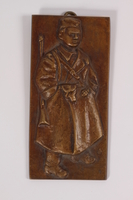
Kurir Jovica plaque, box, and card awarded to a Macedonian Jewish partisan woman
Object
Kurir Jovica plaque set awarded to Jamila (Zamila) Kolonomos on December 16, 1972, by the Council for the Education and Protection of Children of Yugoslavia, to recognize her work with children. The design was inspired by the Kurir Jovica statue, an award for achievement presented by the Yugoslav Union of Pioneers, a society created to indoctrinate children with communist ideology. On April 6, 1941, the Axis powers Germany, Italy, Hungary, and Bulgaria, invaded and partitioned Yugoslavia. The Macedonian region including Bitola where Jamila and her family lived was occupied by Bulgaria. Jamila worked with resistance groups to fight the occupation and was forced to hide at night for her safety. On March 9, 1943, from her hiding place, Jamila witnessed the roundup and deportation of the Jewish community of Bitola. After a month in hiding she went to the mountains and joined a partisan detachment. In August 1943, Jamila’s group became a part of the Macedonian Partisan Battalion, which liberated a prisoner camp in Greece. In June 1944, a separate Macedonian brigade was formed. In August, Jamila was injured during a battle. On October 30, Jamila’s group liberated the towns of Ohrid and Struga and a month later Macedonia was liberated. In December, Jamila served as an official at the Second Congress of Anti-Fascist Youth in Skopje. Around this time Jamila married a fellow partisan Chede Filipovski. Germany surrendered on May 7, 1945. Jamila returned to Bitola and discovered that her entire family had been deported and murdered at Treblinka killing center. In June Chede was killed in a motorcycle accident. In June 1947, Jamila married Avram Sadikario.
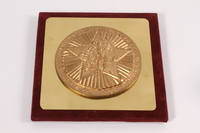
Medallion, box and certificate awarded to Macedonian Jewish partisan woman
Object
Gold medallion set awarded to Jamila (Zamila) Kolonomos on October 11, 2005, for her efforts as a partisan fighter during the Axis occupation of Yugoslavia from 1941 to 1945. On April 6, 1941, the Axis powers Germany, Italy, Hungary, and Bulgaria, invaded and partitioned Yugoslavia. The Macedonian region, including Bitola where Jamila and her family lived, was occupied by Bulgaria. Jamila worked with resistance groups to fight the occupation and was forced to hide at night for her safety. On March 9, 1943, from her hiding place, Jamila witnessed the roundup and deportation of the Jewish community of Bitola. After a month in hiding, she went to the mountains and joined a partisan detachment. In August 1943, Jamila’s group became part of the Macedonian Partisan Battalion, which liberated a prisoner camp in Greece. In June 1944, a separate Macedonian brigade was formed. In August, Jamila was injured during a battle. On October 30, Jamila’s group liberated the towns of Ohrid and Struga, and a month later Macedonia was liberated. In December, Jamila served as an official at the Second Congress of Anti-Fascist Youth in Skopje. Jamila married a fellow partisan Chede Filipovski. Germany surrendered on May 7, 1945. Jamila returned to Bitola and discovered that her entire family had been deported and murdered at Treblinka killing center. In June Chede was killed in a motorcycle accident. In June 1947, Jamila married Avram Sadikario
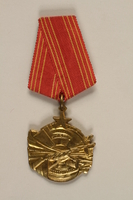
Yugoslav Orden za Hrabrost medal, ribbon, box, and certificate awarded to a Macedonian Jewish partisan woman
Object
Yugoslav Order of Bravery medal set awarded to Jamila (Zamila) Kolonomos on June 3, 1947 in recognition of her efforts as a partisan fighter during World War II. The medal was instituted August 15, 1943 and was awarded to both military personnel and civilians for acts of bravery during World War II. The motto of the Yugoslavian partisan movement, “Death to fascism, freedom to the people” is embossed on the face. On April 6, 1941, the Axis powers, Germany, Italy, Hungary, and Bulgaria, invaded and partitioned Yugoslavia. The Macedonian region, including Bitola where Jamila and her family lived, was occupied by Bulgaria. Jamila worked with resistance groups to fight the occupation and was forced to hide at night for her safety. On March 9, 1943, from her hiding place, Jamila witnessed the roundup and deportation of the Jewish community of Bitola. After a month in hiding, she went to the mountains and joined a partisan detachment. In August 1943, Jamila’s group became part of the Macedonian Partisan Battalion, which liberated a prisoner camp in Greece. In June 1944, a separate Macedonian brigade was formed. In August, Jamila was injured during a battle. On October 30, Jamila’s group liberated the towns of Ohrid and Struga, and a month later Macedonia was liberated. In December, Jamila served as an official at the Second Congress of Anti-Fascist Youth in Skopje. Jamila married a fellow partisan Chede Filipovski. Germany surrendered on May 7, 1945. Jamila returned to Bitola and discovered that her entire family had been deported and murdered at Treblinka killing center. In June Chede was killed in a motorcycle accident. In June 1947, Jamila married Avram Sadikario
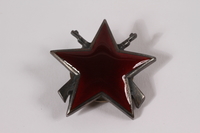
Yugoslavian Order of the Partisan Star awarded to a Macedonian Jewish partisan woman
Object
Yugoslavian Order of the Partisan Star, 3rd class, medal set awarded to Jamila (Zamila) Kolonomos on March 18, 1952, in recognition of her efforts as a partisan fighter during the Axis occupation of Yugoslavia from 1941-1945. This medal was awarded to military leaders for successfully commanding military units and for bravery displayed during WW II. On April 6, 1941, the Axis powers, Germany, Italy, Hungary, and Bulgaria, invaded and partitioned Yugoslavia. The Macedonian region, including Bitola where Jamila and her family lived, was occupied by Bulgaria. Jamila worked with resistance groups to fight the occupation and was forced to hide at night for her safety. On March 9, 1943, from her hiding place, Jamila witnessed the roundup and deportation of the Jewish community of Bitola. After a month in hiding, she went to the mountains and joined a partisan detachment. In August 1943, Jamila’s group became part of the Macedonian Partisan Battalion, which liberated a prisoner camp in Greece. In June 1944, a separate Macedonian brigade was formed. In August, Jamila was injured during a battle. On October 30, Jamila’s group liberated the towns of Ohrid and Struga, and a month later Macedonia was liberated. In December, Jamila served as an official at the Second Congress of Anti-Fascist Youth in Skopje. Jamila married a fellow partisan Chede Filipovski. Germany surrendered on May 7, 1945. Jamila returned to Bitola and discovered that her entire family had been deported and murdered at Treblinka killing center. In June Chede was killed in a motorcycle accident. In June 1947, Jamila married Avram Sadikario.

UNICEF medallion with box awarded to a Macedonian Jewish partisan woman
Object
United Nations International Children's Emergency Fund (UNICEF) medallion awarded to Jamila (Zamila) Kolonomos by the Yugoslav Commission for Cooperation with UNICEF. UNICEF was created to protect the rights and wellbeing of children in response to the chaos of Europe in the aftermath of World War II. Yugoslavia was the first country in Europe to establish a National Committee for UNICEF. In 1965 the Committee changed its name to the Yugoslav Commission for Cooperation with UNICEF. The medallion was awarded after the war to recognize Jamila’s work with the Yugoslav Department for Protection of Mothers and Children. On April 6, 1941, the Axis powers, Germany, Italy, Hungary, and Bulgaria, invaded and partitioned Yugoslavia. The Macedonian region, including Bitola where Jamila and her family lived, was occupied by Bulgaria. Jamila worked with resistance groups to fight the occupation and was forced to hide at night for her safety. On March 9, 1943, from her hiding place, Jamila witnessed the roundup and deportation of the Jewish community of Bitola. After a month in hiding, she went to the mountains and joined a partisan detachment. In August 1943, Jamila’s group became part of the Macedonian Partisan Battalion, which liberated a prisoner camp in Greece. In June 1944, a separate Macedonian brigade was formed. In August, Jamila was injured during a battle. On October 30, Jamila’s group liberated the towns of Ohrid and Struga, and a month later Macedonia was liberated. In December, Jamila served as an official at the Second Congress of Anti-Fascist Youth in Skopje. Jamila married a fellow partisan Chede Filipovski. Germany surrendered on May 7, 1945. Jamila returned to Bitola and discovered that her entire family had been deported and murdered at Treblinka killing center. In June Chede was killed in a motorcycle accident. In June 1947, Jamila married Avram Sadikario.
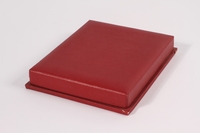
Gold medallion with case awarded to a Macedonian Jewish partisan woman
Object
Gold medallion awarded to Jamila (Zamila) Kolonomos, a partisan fighter during World War II. Jugohrom is the name of a ferroalloy factory that was established in 1952 by the state. The factory was later privatized and is still in operation in Jegunovce, Macedonia, 50 kilometers from Skopje. On April 6, 1941, the Axis powers, Germany, Italy, Hungary, and Bulgaria, invaded and partitioned Yugoslavia. The Macedonian region, including Bitola where Jamila and her family lived, was occupied by Bulgaria. Jamila worked with resistance groups to fight the occupation and was forced to hide at night for her safety. On March 9, 1943, from her hiding place, Jamila witnessed the roundup and deportation of the Jewish community of Bitola. After a month in hiding, she went to the mountains and joined a partisan detachment. In August 1943, Jamila’s group became part of the Macedonian Partisan Battalion, which liberated a prisoner camp in Greece. In June 1944, a separate Macedonian brigade was formed. In August, Jamila was injured during a battle. On October 30, Jamila’s group liberated the towns of Ohrid and Struga, and a month later Macedonia was liberated. In December, Jamila served as an official at the Second Congress of Anti-Fascist Youth in Skopje. Jamila married a fellow partisan Chede Filipovski. Germany surrendered on May 7, 1945. Jamila returned to Bitola and discovered that her entire family had been deported and murdered at Treblinka killing center. In June Chede was killed in a motorcycle accident. In June 1947, Jamila married Avram Sadikario.
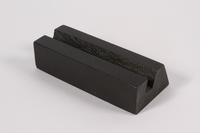
Macedonian-Kosovo Brigade plaque with stand awarded to a Macedonian Jewish partisan woman
Object
Plaque awarded to Jamila (Zamila) Kolonomos commemorating the creation of the Macedonian-Kosovo Brigade which she served in during the Axis occupation of Yugoslavia from 1941-1945. The brigade was created on November 11, 1943, with 800 troops and by the end of the war numbered 66,000 members. On April 6, 1941, the Axis powers, Germany, Italy, Hungary, and Bulgaria, invaded and partitioned Yugoslavia. The Macedonian region, including Bitola where Jamila and her family lived, was occupied by Bulgaria. Jamila worked with resistance groups to fight the occupation and was forced to hide at night for her safety. On March 9, 1943, from her hiding place, Jamila witnessed the roundup and deportation of the Jewish community of Bitola. After a month in hiding, she went to the mountains and joined a partisan detachment. In August 1943, Jamila’s group became part of the Macedonian Partisan Battalion, which liberated a prisoner camp in Greece. In June 1944, a separate Macedonian brigade was formed. In August, Jamila was injured during a battle. On October 30, Jamila’s group liberated the towns of Ohrid and Struga, and a month later Macedonia was liberated. In December, Jamila served as an official at the Second Congress of Anti-Fascist Youth in Skopje. Jamila married a fellow partisan Chede Filipovski. Germany surrendered on May 7, 1945. Jamila returned to Bitola and discovered that her entire family had been deported and murdered at Treblinka killing center. In June Chede was killed in a motorcycle accident. In June 1947, Jamila married Avram Sadikario.
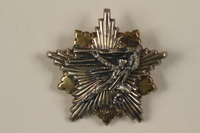
Partizanska spomenica medal awarded to a Macedonian Jewish partisan woman
Object
Partizanska spomenica medal awarded to Jamila (Zamila) Kolonomos for her service as a partisan during the Axis occupation of Yugoslavia from 1941-1945. Of the 27,629 medals awarded, only 12 of them went to Jews who, like Jamila, were from Bitola. The medal was first instituted in 1943, and the design revised to this version in 1945. On April 6, 1941, the Axis powers, Germany, Italy, Hungary, and Bulgaria, invaded and partitioned Yugoslavia. The Macedonian region, including Bitola where Jamila and her family lived, was occupied by Bulgaria. Jamila worked with resistance groups to fight the occupation and was forced to hide at night for her safety. On March 9, 1943, from her hiding place, Jamila witnessed the roundup and deportation of the Jewish community of Bitola. After a month in hiding, she went to the mountains and joined a partisan detachment. In August 1943, Jamila’s group became part of the Macedonian Partisan Battalion, which liberated a prisoner camp in Greece. In June 1944, a separate Macedonian brigade was formed. In August, Jamila was injured during a battle. On October 30, Jamila’s group liberated the towns of Ohrid and Struga, and a month later Macedonia was liberated. In December, Jamila served as an official at the Second Congress of Anti-Fascist Youth in Skopje. Jamila married a fellow partisan Chede Filipovski. Germany surrendered on May 7, 1945. Jamila returned to Bitola and discovered that her entire family had been deported and murdered at Treblinka killing center. In June Chede was killed in a motorcycle accident. In June 1947, Jamila married Avram Sadikario.
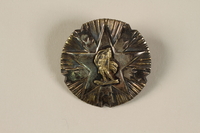
Orden Zasluge Za Narod 2nd class awarded to a Macedonian Jewish partisan woman
Object
Yugoslav Order of Merit to the Nation (People), 2nd class, awarded to Jamila (Zamila) Kolonomos in recognition of her service as a partisan during the Axis occupation of Yugoslavia from 1941-1945. The medal was awarded to those who distinguished themselves in the struggle for liberation and merit in securing and organizing the Yugoslav government and army, and for achievement in the economic, cultural and social spheres. This medal was awarded to 39534 people. On April 6, 1941, the Axis powers, Germany, Italy, Hungary, and Bulgaria, invaded and partitioned Yugoslavia. The Macedonian region, including Bitola where Jamila and her family lived, was occupied by Bulgaria. Jamila worked with resistance groups to fight the occupation and was forced to hide at night for her safety. On March 9, 1943, from her hiding place, Jamila witnessed the roundup and deportation of the Jewish community of Bitola. After a month in hiding, she went to the mountains and joined a partisan detachment. In August 1943, Jamila’s group became part of the Macedonian Partisan Battalion, which liberated a prisoner camp in Greece. In June 1944, a separate Macedonian brigade was formed. In August, Jamila was injured during a battle. On October 30, Jamila’s group liberated the towns of Ohrid and Struga, and a month later Macedonia was liberated. In December, Jamila served as an official at the Second Congress of Anti-Fascist Youth in Skopje. Jamila married a fellow partisan Chede Filipovski. Germany surrendered on May 7, 1945. Jamila returned to Bitola and discovered that her entire family had been deported and murdered at Treblinka killing center. In June Chede was killed in a motorcycle accident. In June 1947, Jamila married Avram Sadikario.
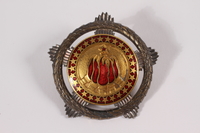
Orden Bratstva I Jedinstva awarded to a Macedonian Jewish partisan woman
Object
Order of Brotherhood and Unity 1st class medal awarded to Jamila (Zamila) Kolonomos in recognition of her service as a partisan during the Axis occupation of Yugoslavia from 1941-1945. The medal was awarded to both citizens and foreigners for creation and promotion of brotherhood and unity when the resistance movement was divided by politics, nationality and other factors. On April 6, 1941, the Axis powers, Germany, Italy, Hungary, and Bulgaria, invaded and partitioned Yugoslavia. The Macedonian region, including Bitola where Jamila and her family lived, was occupied by Bulgaria. Jamila worked with resistance groups to fight the occupation and was forced to hide at night for her safety. On March 9, 1943, from her hiding place, Jamila witnessed the roundup and deportation of the Jewish community of Bitola. After a month in hiding, she went to the mountains and joined a partisan detachment. In August 1943, Jamila’s group became part of the Macedonian Partisan Battalion, which liberated a prisoner camp in Greece. In June 1944, a separate Macedonian brigade was formed. In August, Jamila was injured during a battle. On October 30, Jamila’s group liberated the towns of Ohrid and Struga, and a month later Macedonia was liberated. In December, Jamila served as an official at the Second Congress of Anti-Fascist Youth in Skopje. Jamila married a fellow partisan Chede Filipovski. Germany surrendered on May 7, 1945. Jamila returned to Bitola and discovered that her entire family had been deported and murdered at Treblinka killing center. In June Chede was killed in a motorcycle accident. In June 1947, Jamila married Avram Sadikario.

Ordena Republike Sa Srebrnim Vencem awarded to a Macedonian Jewish partisan woman
Object
Order of the Republic awarded to Jamila (Zamila) Kolonomos a WWII partisan fighter on November 7, 1961, in recognition for civil merits and public activities, achievements in science and art, education and enlightenment, culture and sports. On April 6, 1941, the Axis powers, Germany, Italy, Hungary, and Bulgaria, invaded and partitioned Yugoslavia. The Macedonian region, including Bitola where Jamila and her family lived, was occupied by Bulgaria. Jamila worked with resistance groups to fight the occupation and was forced to hide at night for her safety. On March 9, 1943, from her hiding place, Jamila witnessed the roundup and deportation of the Jewish community of Bitola. After a month in hiding, she went to the mountains and joined a partisan detachment. In August 1943, Jamila’s group became part of the Macedonian Partisan Battalion, which liberated a prisoner camp in Greece. In June 1944, a separate Macedonian brigade was formed. In August, Jamila was injured during a battle. On October 30, Jamila’s group liberated the towns of Ohrid and Struga, and a month later Macedonia was liberated. In December, Jamila served as an official at the Second Congress of Anti-Fascist Youth in Skopje. Jamila married a fellow partisan Chede Filipovski. Germany surrendered on May 7, 1945. Jamila returned to Bitola and discovered that her entire family had been deported and murdered at Treblinka killing center. In June Chede was killed in a motorcycle accident. In June 1947, Jamila married Avram Sadikario.
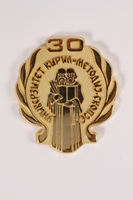
30th anniversary hospital medallion and box awarded to a Macedonian Jewish man
Object
Medallion awarded to Dr. Avram Sadikario in 1979 from the Saints Cyril and Methodius University of Skopje, Yugoslavia (now North Macedannia), where Avram began teaching in 1952. The medallion bears the University’s emblem and was awarded to celebrate the 30th anniversary of its founding. Avram Sadikario was in his third year of studying medicine at the University of Belgrade when the Axis powers declared war on Yugoslavia. On April 4, 1941 he left Belgrade and returned to Bitola. Two days later Germany, Italy, Hungary, and Bulgaria invaded and partitioned Yugoslavia and the Macedonian region was occupied by Bulgaria. Anti-Jewish laws were passed that restricted Avram and his family’s lives. Later that year, Avram joined the Yugoslav Communist Party serving in and founding several underground resistance cells. In 1942 Avram accompanied his brother Sami to Sofia, Bulgaria for medical treatment. While he was gone, his resistance cell was discovered and Avram did not return home with his brother. He remained in Sofia and went into hiding. In spring 1943, Jews were expelled from the city and Avram traveled to a camp in Pleven and was held there until the end of summer. On September 8 1944, he participated in the liberation of the central prison where he remained until he was liberated by the Soviets. Germany surrendered May 7, 1945. After liberation, Avram worked for several months as state security and then as a doctor in Pleven. In June, 1947, Avram married partisan fighter Jamila Kolonomos.
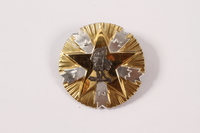
Orden Zasluge Za Narod awarded to a Macedonian Jewish partisan woman
Object
Yugoslav Order of Merit to the Nation (People), 1st class awarded to Jamila (Zmila) Kolonomos in 1975, in recognition of her service as a partisan during the Axis occupation of Yugoslavia from 1941-1945. The medal was awarded to those who distinguished themselves in the struggle for liberation and merit in securing and organizing the Yugoslav government and army, and for achievement in the economic, cultural and social spheres. On April 6, 1941, the Axis powers, Germany, Italy, Hungary, and Bulgaria, invaded and partitioned Yugoslavia. The Macedonian region, including Bitola where Jamila and her family lived, was occupied by Bulgaria. Jamila worked with resistance groups to fight the occupation and was forced to hide at night for her safety. On March 9, 1943, from her hiding place, Jamila witnessed the roundup and deportation of the Jewish community of Bitola. After a month in hiding, she went to the mountains and joined a partisan detachment. In August 1943, Jamila’s group became part of the Macedonian Partisan Battalion, which liberated a prisoner camp in Greece. In June 1944, a separate Macedonian brigade was formed. In August, Jamila was injured during a battle. On October 30, Jamila’s group liberated the towns of Ohrid and Struga, and a month later Macedonia was liberated. In December, Jamila served as an official at the Second Congress of Anti-Fascist Youth in Skopje. Jamila married a fellow partisan Chede Filipovski. Germany surrendered on May 7, 1945. Jamila returned to Bitola and discovered that her entire family had been deported and murdered at Treblinka killing center. In June Chede was killed in a motorcycle accident. In June 1947, Jamila married Avram Sadikario.
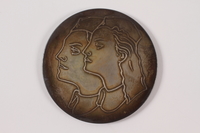
Medallion and box awarded to a Macedonian Jewish partisan woman
Object
Medallion awarded to Jamila (Zamila) Kolonomos by the Women’s Anti-Fascist Front of Macedonia (AFZ). The organization was formed in 1944 with the goal of improving schooling for females and increasing involvement of women in politics and promoting women’s rights. Many of the members of the organization fought as partisans during World War II. On April 6, 1941, the Axis powers, Germany, Italy, Hungary, and Bulgaria, invaded and partitioned Yugoslavia. The Macedonian region, including Bitola where Jamila and her family lived, was occupied by Bulgaria. Jamila worked with resistance groups to fight the occupation and was forced to hide at night for her safety. On March 9, 1943, from her hiding place, Jamila witnessed the roundup and deportation of the Jewish community of Bitola. After a month in hiding, she went to the mountains and joined a partisan detachment. In August 1943, Jamila’s group became part of the Macedonian Partisan Battalion, which liberated a prisoner camp in Greece. In June 1944, a separate Macedonian brigade was formed. In August, Jamila was injured during a battle. On October 30, Jamila’s group liberated the towns of Ohrid and Struga, and a month later Macedonia was liberated. In December, Jamila served as an official at the Second Congress of Anti-Fascist Youth in Skopje. Jamila married a fellow partisan Chede Filipovski. Germany surrendered on May 7, 1945. Jamila returned to Bitola and discovered that her entire family had been deported and murdered at Treblinka killing center. In June Chede was killed in a motorcycle accident. In June 1947, Jamila married Avram Sadikario.
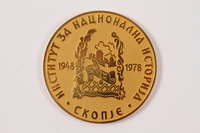
30th Anniversary medallion from the Institute for National History in Skopje
Object
Medallion awarded to Jamila (Zamila) Kolonomos by the Institute for National History in Skopje, Macedonia. The Institute was founded in 1948 and is one of Saints Cyril and Methodius University’s 5 research institutes. It is a public institution that focuses on studying the history of Macedonia and postgraduate and doctoral studies. Jamila was a professor at the University and wrote about the history of Jews in the region. On April 6, 1941, the Axis powers, Germany, Italy, Hungary, and Bulgaria, invaded and partitioned Yugoslavia. The Macedonian region, including Bitola where Jamila and her family lived, was occupied by Bulgaria. Jamila worked with resistance groups to fight the occupation and was forced to hide at night for her safety. On March 9, 1943, from her hiding place, Jamila witnessed the roundup and deportation of the Jewish community of Bitola. After a month in hiding, she went to the mountains and joined a partisan detachment. In August 1943, Jamila’s group became part of the Macedonian Partisan Battalion, which liberated a prisoner camp in Greece. In June 1944, a separate Macedonian brigade was formed. In August, Jamila was injured during a battle. On October 30, Jamila’s group liberated the towns of Ohrid and Struga, and a month later Macedonia was liberated. In December, Jamila served as an official at the Second Congress of Anti-Fascist Youth in Skopje. Jamila married a fellow partisan Chede Filipovski. Germany surrendered on May 7, 1945. Jamila returned to Bitola and discovered that her entire family had been deported and murdered at Treblinka killing center. In June Chede was killed in a motorcycle accident. In June 1947, Jamila married Avram Sadikario.
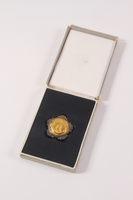
Orden Rada Sa Zlatnim Vencem awarded to a Macedonian Jewish partisan woman
Object
Yugoslav Order of Labor (with the Golden Wreath) 2nd class awarded to Jamila (Zamila) Kolonomos for her contributions to the economy, production and building communism. The medal was awarded to citizens, collectives and military units. On April 6, 1941, the Axis powers, Germany, Italy, Hungary, and Bulgaria, invaded and partitioned Yugoslavia. The Macedonian region, including Bitola where Jamila and her family lived, was occupied by Bulgaria. Jamila worked with resistance groups to fight the occupation and was forced to hide at night for her safety. On March 9, 1943, from her hiding place, Jamila witnessed the roundup and deportation of the Jewish community of Bitola. After a month in hiding, she went to the mountains and joined a partisan detachment. In August 1943, Jamila’s group became part of the Macedonian Partisan Battalion, which liberated a prisoner camp in Greece. In June 1944, a separate Macedonian brigade was formed. In August, Jamila was injured during a battle. On October 30, Jamila’s group liberated the towns of Ohrid and Struga, and a month later Macedonia was liberated. In December, Jamila served as an official at the Second Congress of Anti-Fascist Youth in Skopje. Jamila married a fellow partisan Chede Filipovski. Germany surrendered on May 7, 1945. Jamila returned to Bitola and discovered that her entire family had been deported and murdered at Treblinka killing center. In June Chede was killed in a motorcycle accident. In June 1947, Jamila married Avram Sadikario.
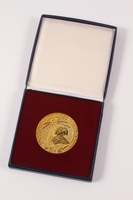
Commemorative medallion awarded to a Macedonian Jewish partisan woman
Object
Medallion awarded to Jamila (Zamila) Kolonomos by the Council for the Care and Education of Children of Macedonia and The Union of the Pioneers of Yugoslavia. The medallion was awarded for Jamila’s work with children’s organizations. On April 6, 1941, the Axis powers, Germany, Italy, Hungary, and Bulgaria, invaded and partitioned Yugoslavia. The Macedonian region, including Bitola where Jamila and her family lived, was occupied by Bulgaria. Jamila worked with resistance groups to fight the occupation and was forced to hide at night for her safety. On March 9, 1943, from her hiding place, Jamila witnessed the roundup and deportation of the Jewish community of Bitola. After a month in hiding, she went to the mountains and joined a partisan detachment. In August 1943, Jamila’s group became part of the Macedonian Partisan Battalion, which liberated a prisoner camp in Greece. In June 1944, a separate Macedonian brigade was formed. In August, Jamila was injured during a battle. On October 30, Jamila’s group liberated the towns of Ohrid and Struga, and a month later Macedonia was liberated. In December, Jamila served as an official at the Second Congress of Anti-Fascist Youth in Skopje. Jamila married a fellow partisan Chede Filipovski. Germany surrendered on May 7, 1945. Jamila returned to Bitola and discovered that her entire family had been deported and murdered at Treblinka killing center. In June Chede was killed in a motorcycle accident. In June 1947, Jamila married Avram Sadikario.
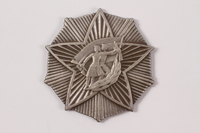
SUBNOR medallion awarded to a Macedonian Jewish partisan woman
Object
Medallion awarded to Jamila (Zamila) Kolonomos by SUBNOR in Yugoslavia, an organization formed in 1961 in Yugoslavia, by merging the Combat Union of War Veterans, the Association of War Officers, and Associations of Reserve Officers and Sub-Officers. The goal of this organization was to preserve the heritage of the war, participation in the reconstruction of the country and aid disabled veterans, and the families of the deceased. On April 6, 1941, the Axis powers, Germany, Italy, Hungary, and Bulgaria, invaded and partitioned Yugoslavia. The Macedonian region, including Bitola where Jamila and her family lived, was occupied by Bulgaria. Jamila worked with resistance groups to fight the occupation and was forced to hide at night for her safety. On March 9, 1943, from her hiding place, Jamila witnessed the roundup and deportation of the Jewish community of Bitola. After a month in hiding, she went to the mountains and joined a partisan detachment. In August 1943, Jamila’s group became part of the Macedonian Partisan Battalion, which liberated a prisoner camp in Greece. In June 1944, a separate Macedonian brigade was formed. In August, Jamila was injured during a battle. On October 30, Jamila’s group liberated the towns of Ohrid and Struga, and a month later Macedonia was liberated. In December, Jamila served as an official at the Second Congress of Anti-Fascist Youth in Skopje. Jamila married a fellow partisan Chede Filipovski. Germany surrendered on May 7, 1945. Jamila returned to Bitola and discovered that her entire family had been deported and murdered at Treblinka killing center. In June Chede was killed in a motorcycle accident. In June 1947, Jamila married Avram Sadikario.

Military medallion, box and paper awarded to a Macedonian Jewish partisan woman
Object
Award received by Jamila (Zamila) Kolonomos in recognition of her service as a partisan during the Axis occupation of Yugoslavia from 1941-1945. On April 6, 1941, the Axis powers, Germany, Italy, Hungary, and Bulgaria, invaded and partitioned Yugoslavia. The Macedonian region, including Bitola where Jamila and her family lived, was occupied by Bulgaria. Jamila worked with resistance groups to fight the occupation and was forced to hide at night for her safety. On March 9, 1943, from her hiding place, Jamila witnessed the roundup and deportation of the Jewish community of Bitola. After a month in hiding, she went to the mountains and joined a partisan detachment. In August 1943, Jamila’s group became part of the Macedonian Partisan Battalion, which liberated a prisoner camp in Greece. In June 1944, a separate Macedonian brigade was formed. In August, Jamila was injured during a battle. On October 30, Jamila’s group liberated the towns of Ohrid and Struga, and a month later Macedonia was liberated. In December, Jamila served as an official at the Second Congress of Anti-Fascist Youth in Skopje. Jamila married a fellow partisan Chede Filipovski. Germany surrendered on May 7, 1945. Jamila returned to Bitola and discovered that her entire family had been deported and murdered at Treblinka killing center. In June Chede was killed in a motorcycle accident. In June 1947, Jamila married Avram Sadikario.
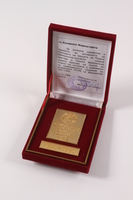
Military service medallion awarded to a Macedonian Jewish partisan woman
Object
Medallion awarded to Jamila (Zamila) Kolonomos on November 11, 1998, in recognition of her service as a partisan during the Axis occupation of Yugoslavia from 1941-1945. On April 6, 1941, the Axis powers, Germany, Italy, Hungary, and Bulgaria, invaded and partitioned Yugoslavia. The Macedonian region, including Bitola where Jamila and her family lived, was occupied by Bulgaria. Jamila worked with resistance groups to fight the occupation and was forced to hide at night for her safety. On March 9, 1943, from her hiding place, Jamila witnessed the roundup and deportation of the Jewish community of Bitola. After a month in hiding, she went to the mountains and joined a partisan detachment. In August 1943, Jamila’s group became part of the Macedonian Partisan Battalion, which liberated a prisoner camp in Greece. In June 1944, a separate Macedonian brigade was formed. In August, Jamila was injured during a battle. On October 30, Jamila’s group liberated the towns of Ohrid and Struga, and a month later Macedonia was liberated. In December, Jamila served as an official at the Second Congress of Anti-Fascist Youth in Skopje. Jamila married a fellow partisan Chede Filipovski. Germany surrendered on May 7, 1945. Jamila returned to Bitola and discovered that her entire family had been deported and murdered at Treblinka killing center. In June Chede was killed in a motorcycle accident. In June 1947, Jamila married Avram Sadikario.
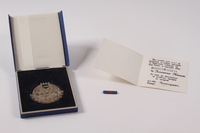
Medallion, box, pamphlet, and bar pin awarded to a Macedonian Jewish partisan woman
Object
Medallion awarded to Jamila (Zamila) Kolonomos in 1965, in recognition of her service as a partisan during the Axis occupation of Yugoslavia from 1941-1945 and to commemorate the anniversary of the end of World War II. On April 6, 1941, the Axis powers, Germany, Italy, Hungary, and Bulgaria, invaded and partitioned Yugoslavia. The Macedonian region, including Bitola where Jamila and her family lived, was occupied by Bulgaria. Jamila worked with resistance groups to fight the occupation and was forced to hide at night for her safety. On March 9, 1943, from her hiding place, Jamila witnessed the roundup and deportation of the Jewish community of Bitola. After a month in hiding, she went to the mountains and joined a partisan detachment. In August 1943, Jamila’s group became part of the Macedonian Partisan Battalion, which liberated a prisoner camp in Greece. In June 1944, a separate Macedonian brigade was formed. In August, Jamila was injured during a battle. On October 30, Jamila’s group liberated the towns of Ohrid and Struga, and a month later Macedonia was liberated. In December, Jamila served as an official at the Second Congress of Anti-Fascist Youth in Skopje. Jamila married a fellow partisan Chede Filipovski. Germany surrendered on May 7, 1945. Jamila returned to Bitola and discovered that her entire family had been deported and murdered at Treblinka killing center. In June Chede was killed in a motorcycle accident. In June 1947, Jamila married Avram Sadikario.
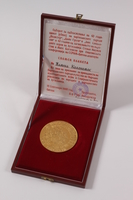
Commemorative medallion with box awarded to a Macedonian Jewish partisan woman
Object
Medallion awarded to Jamila (Zamilla) Kolonomos in 1982 in recognition of her service as a partisan during the Axis occupation of Yugoslavia from 1941-1945. The three partisan groups mentioned on the case, the Jane Sandinski, the Pelister, and Dame Gruev were all formed around the Bitola region in Macedonia in 1942. Jamila served with Damjan Gruev partisan group. On April 6, 1941, the Axis powers, Germany, Italy, Hungary, and Bulgaria, invaded and partitioned Yugoslavia. The Macedonian region, including Bitola where Jamila and her family lived, was occupied by Bulgaria. Jamila worked with resistance groups to fight the occupation and was forced to hide at night for her safety. On March 9, 1943, from her hiding place, Jamila witnessed the roundup and deportation of the Jewish community of Bitola. After a month in hiding, she went to the mountains and joined a partisan detachment. In August 1943, Jamila’s group became part of the Macedonian Partisan Battalion, which liberated a prisoner camp in Greece. In June 1944, a separate Macedonian brigade was formed. In August, Jamila was injured during a battle. On October 30, Jamila’s group liberated the towns of Ohrid and Struga, and a month later Macedonia was liberated. In December, Jamila served as an official at the Second Congress of Anti-Fascist Youth in Skopje. Jamila married a fellow partisan Chede Filipovski. Germany surrendered on May 7, 1945. Jamila returned to Bitola and discovered that her entire family had been deported and murdered at Treblinka killing center. In June Chede was killed in a motorcycle accident. In June 1947, Jamila married Avram Sadikario.
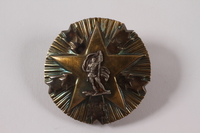
Orden Zasluge Za Narod awarded to a Macedonian Jewish partisan woman
Object
Yugoslav Order of Merit to the Nation (People), 3rd class, awarded to Jamila (Zamila) Kolonomos in recognition of her service as a partisan during the Axis occupation of Yugoslavia from 1941-1945. The medal was awarded to those who distinguished themselves in the struggle for liberation and merit in securing and organizing the Yugoslav government and army, and for achievement in the economic, cultural and social spheres. On April 6, 1941, the Axis powers, Germany, Italy, Hungary, and Bulgaria, invaded and partitioned Yugoslavia. The Macedonian region, including Bitola where Jamila and her family lived, was occupied by Bulgaria. Jamila worked with resistance groups to fight the occupation and was forced to hide at night for her safety. On March 9, 1943, from her hiding place, Jamila witnessed the roundup and deportation of the Jewish community of Bitola. After a month in hiding, she went to the mountains and joined a partisan detachment. In August 1943, Jamila’s group became part of the Macedonian Partisan Battalion, which liberated a prisoner camp in Greece. In June 1944, a separate Macedonian brigade was formed. In August, Jamila was injured during a battle. On October 30, Jamila’s group liberated the towns of Ohrid and Struga, and a month later Macedonia was liberated. In December, Jamila served as an official at the Second Congress of Anti-Fascist Youth in Skopje. Jamila married a fellow partisan Chede Filipovski. Germany surrendered on May 7, 1945. Jamila returned to Bitola and discovered that her entire family had been deported and murdered at Treblinka killing center. In June Chede was killed in a motorcycle accident. In June 1947, Jamila married Avram Sadikario.
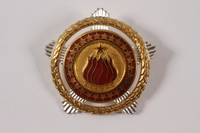
Orden Bratstva I Jedinstva Sa Zlatnim Vengem awarded to a Macedonian Jewish partisan woman
Object
Order of Brotherhood and Unity medal awarded to Jamila (Zamila) Kolonomos in 1950, in recognition of her service as a partisan during the Axis occupation of Yugoslavia from 1941-1945. The medal was awarded to both citizens and foreigners for creation and promotion of brotherhood and unity when resistance was divided by politics, nationality, and other factors. On April 6, 1941, the Axis powers, Germany, Italy, Hungary, and Bulgaria, invaded and partitioned Yugoslavia. The Macedonian region, including Bitola where Jamila and her family lived, was occupied by Bulgaria. Jamila worked with resistance groups to fight the occupation and was forced to hide at night for her safety. On March 9, 1943, from her hiding place, Jamila witnessed the roundup and deportation of the Jewish community of Bitola. After a month in hiding, she went to the mountains and joined a partisan detachment. In August 1943, Jamila’s group became part of the Macedonian Partisan Battalion, which liberated a prisoner camp in Greece. In June 1944, a separate Macedonian brigade was formed. In August, Jamila was injured during a battle. On October 30, Jamila’s group liberated the towns of Ohrid and Struga, and a month later Macedonia was liberated. In December, Jamila served as an official at the Second Congress of Anti-Fascist Youth in Skopje. Jamila married a fellow partisan Chede Filipovski. Germany surrendered on May 7, 1945. Jamila returned to Bitola and discovered that her entire family had been deported and murdered at Treblinka killing center. In June Chede was killed in a motorcycle accident. In June 1947, Jamila married Avram Sadikario.
Jamila Kolonomos collection
Document
Consists of a collection of 67 pre-war, wartime, and post-war photographs of Macedonian survivors, resistance fighters, and rescuers. The photographs were used in "Monastir without Jews: Recollections of a Jewish partisan in Macedonia" by Jamila Kolonomos. Contains photographs of Ms. Kolonomos, her family, and members of the partisan group known as the Macedonian Brigade. Also contains one CD of the images.
Oral testimony of Avram Sadikario
Oral History
Jamila Kolonomos papers
Document
Contains a postcard from Haim Koen sent during the deportation from Bitola, Macedonia on March 11, 1943, to his relative Avram Sadikarios in Sofia, Bulgaria. Mr. Koen writes that he was taken from his home to the train station and he doesn’t know where he will be taken; he asks Avram and Moise to take care of his daughter Sola Koen and not to spare expenses. Also includes a photograph showing Sola Koen in Israel after the war.
Avram Sadikario collection
Document
Collection of photographs and documents relating to the scientific career of Avram Sadikario and Jamila Kolonomos as well as commemorations of the deportation from Bitola, Macedonia. Includes three postcards mailed from Bitola and Skopje in February and March 1943 to Avram Sadikario (donor's late husband) in Sofia, by his brother Sami (later murdered by the Ustasha) and a relative named Mayer Aruesti.



